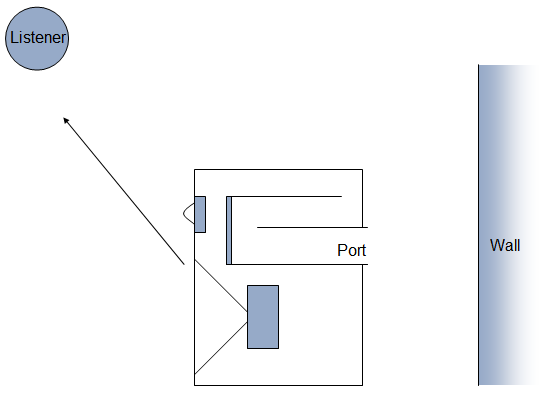Giving Deeper Bass to a Bookshelf Speaker
6 Nov 2013
The 2-way Boston Acoustics Classic Series 26 speakers (6" woofer, 1" tweeter) offered mostly faithful reproduction of sound at a low price ($125 each). Measuring their frequency response yields relatively flat pass-band except for an audible notch at 3kHz, resulting from a poor cross-over and destructive interference between the woofer and sound reflected from the back wall of the speaker.

CS26 Frequency response*. Ignore the sub-100Hz part due to a limitation of my equipment.
Speaker/room EQ can easily correct for the dip, so the real weakness of the speaker is lack of deep bass, which here we will correct (I listen to them without a subwoofer).
The speakers' bass reflex port can be improved in 2 ways.:
- The port was originally tuned at 55 Hz. I wanted to bring the resonance lower for deeper bass - basically consciously trade off SPL at 50-60 Hz for reachability of 30-40 Hz.
- The port is right behind the woofer, passing the mid-range straight trough. These waves then reflect back from objects behind the speaker, creating a noticeable interference pattern, as seen in the below figure. That's quite common with all straight port designs - play a 1 kHz tone through your speakers and move your head around - the notches and peaks will be very obvious.

The bass reflex passes mid-band signals straight-through, which interfere with frontal sound.
The port length is roughly inversely proportional to the square of the resonance frequency. I wanted to bring the resonance to around 45 Hz, or a 50% increase in port length. That would make the port longer than the depth of the speaker. Fortunately, the way I solved this, also mostly eliminated the mid-band pass through problem - I made a turn inside the port, midway through.

Serpentine bass port has lower resonance and blocks unwanted signals. I used sound blocking rubber on the outer side of the turn.
I constructed the new port from 2" ABS (aka gutter) pipes and ABS cement (which actually disolves the plastic and makes the final pieces appear molded).

2" ABS pipe cut into the right segment lengths for the new port.

New port completed. To fit the opening at the back of the speaker, I had to sand down the pipe at the end. Also note the smoothly sanded inner end to prevent wind noise.

The new port is held in place by friction fit and reinforcement using hot glue (just like the original)

New port on the inside.
After I put the speaker back together, the resonance now is exactly at 45 Hz (yay!) and bass response has not only got deeper by about 10Hz, but also luckily the bass fall off turned out smooth, without boomy resonances. Expectedly the cone displacement is drastically reduced around 40-50 Hz for seemingly unchanged sensitivity. Now occasionally I look at the modded speaker and am amused how this little box can pack this deep bass :-)

CS26 Marketing Pics

Original port, made from plastic and paper.
*- data/plot generated from Rightmark Audio Analyzer.
Comments for Giving Deeper Bass to a Bookshelf Speaker
Abs Pipe on March 12, 2014
Very well said. These tips are really amazing. I appreciate it for sharing them.